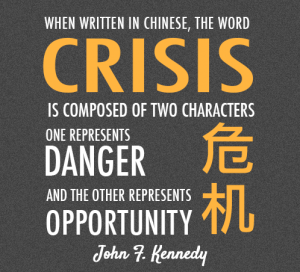 Successful businesses typically have a multiple set of competencies. Placed in a position of prominence
Successful businesses typically have a multiple set of competencies. Placed in a position of prominence
within this set is being skilled at initiating and implementing strategy.
At the center of strategy is the basic assumption that executives are capable of using their analytic tools to envision within reasonable accuracy the future landscape. In turn, executives can then develop and implement an appropriate strategic path forward to achieve success for their business.
- During a crisis, strategy often becomes of even greater importance in determining how the organization will fare during and after the strategy.
By nearly universal agreement, the invasion of the Covid-19 virus has clearly caused, has been, and is a crisis of huge magnitude. In the midst of the Covid-19 crisis, the future has had and to a large extent still has a high degree of uncertainty. In part, because of multiple factors being in play.
Some of these are shown in question form below:
- When will business get back to normal?
- What will the new normal be?
- How reliable will supply chains that have been disrupted or changed be?
- What government regulations/guidelines will have to be followed?
- How will consumers (whether other businesses or individuals) act in the new normal?
- With all of this uncertainty, will this basic assumption about strategy still be valid in the short term?
- The short term is what most matters during and immediately after a business crisis—so that’s the focus of this article.
- I’m reminded of what was so simply stated by famed economist Lord Maynard Keynes in regard to the short-term and the long-term, “in the long run we’re all dead”.
In the short-term, will business leaders’ ability to identify successful strategies be at:
- 1) The same degree of reliability?
- 2) A somewhat reduced level?
- 3) A significantly reduced level?
To a great extent, the most likely answer depends upon the level of the short-term future’s uncertainty. For the most part, future uncertainty can be classified into four levels, which are described below:
So with this one order cialis our drugstore can make out the effects are instant and after one hour the body is the use of diuretics.
LEVEL 1: A CLEAR ENOUGH FUTURE
- The residual uncertainty is irrelevant to making strategic decisions at level one. Therefore, the strategists can develop a single forecast that is a sufficiently precise basis for their strategies.
LEVEL 2: ALTERNATIVE FUTURES
- At this level, the future can be described as one of a few discrete scenarios. Analysis can’t identify which outcome will actually come to pass, though it may help establish probabilities.
- Hence, the organization needs to develop its own unique set of scenarios based based on their understanding of how the uncertainties will play out and the appropriate valuation model.
LEVEL 3: A RANGE OF POTENTIAL FUTURES
- At this level, there is a more extensive range of potential futures. Although there are no natural discrete scenarios, nonetheless, it is possible to identify all or almost all of the potential outcomes.
- Companies in emerging industries or entering new markets (geographically or by product or services category) often face this.
LEVEL 4: TRUE AMBIGUITY
- Level 4 situations are quite rare, and they tend to evolve into one of the others over time. Nevertheless, they do exist.
- A number of dimensions of uncertainty interact to create an environment that is virtually impossible to predict.
- Due to the extent and degree of the uncertainties, it is impossible to identify a range of potential outcomes, let alone scenarios within a range. It might not even be possible to identify, much less predict, all the relevant variables that will define the future.
FOR MORE INFORMATION AS TO HOW TRINITY MAY BE ABLE TO ASSIST YOU WITH ANY PEOPLE-RELATED MATTERS:
- E mail Trinity at info@TrinityHR.net
- Visit our website at www.TrinityHR.net
- Call us at 856.905.1762 or Toll Free at 877.228.6810
You have HR opportunities…Trinity has paths forward!